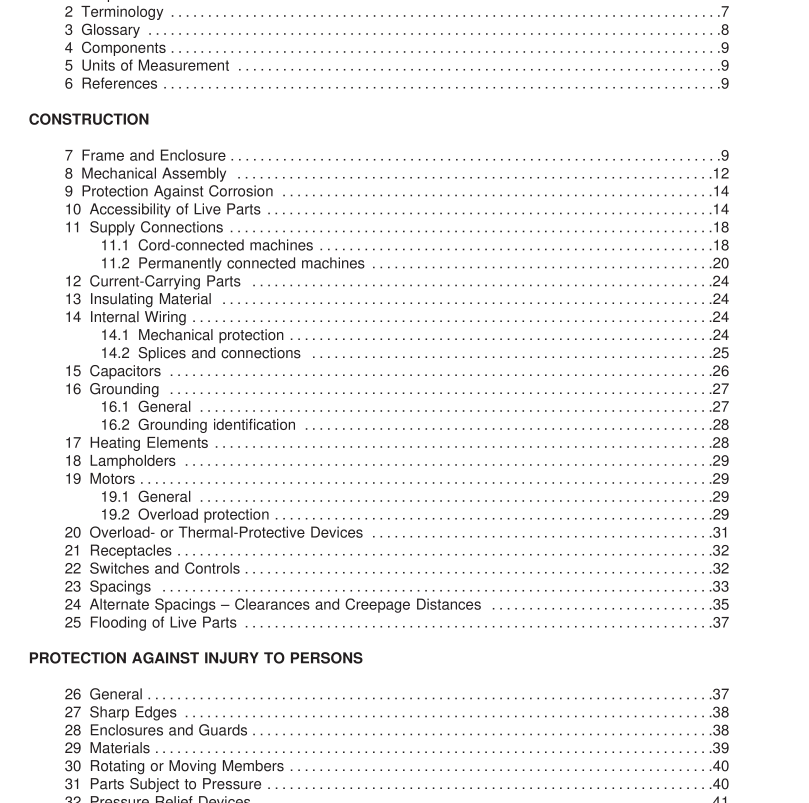UL 763:2010 free download Motor-Operated Commercial Food Preparing Machines
1 Scope
1.1 These requirements cover commercial motor-operated food-preparing machines intended for use inaccordance with the National Electrical Code.
1.2These requirements do not cover machines rated more than 600 v; nor do they cover machinesinvolving universal motors rated more than 250 v.
1.3 These requirements cover coffee grinders,vegetable cutters, food mixers, nonrefrigerated ice cubedispensers,and other motor-operated machines usually found in commercial kitchens, restaurants, foodprocessing establishments,bakeries,or other business establishments where food is prepared orprocessed.
1.4 A machine that utilizes some other source of energy, such as gas or steam, in addition to electricenergy will be investigated under these requirements and under such additional requirements as areapplicable to the machine under consideration.
:1.5 A product that contains features, characteristics, components, materials, or systems new or differentfrom those covered by the requirements in this standard, and that involves a risk of fire or of electric shockor injury to persons shall be evaluated using appropriate additional component and end-productrequirements to maintain the level of safety as originally anticipated by the intent of this standard.Aproduct whose features,characteristics,components,materials,or systems conflict with specificrequirements or provisions of this standard does not comply with this standard.Revision of requirementsshall be proposed and adopted in conformance with the methods employed for development, revision, andimplementation of this standard.
2 Terminology
2.1 ln the following text, a requirement that applies only to a specific type or types of commercialfood-preparing machine is identified by a specific reference in the requirement to the type or types ofmachine involved.Absence of such a specific reference or use of the term machine indicates that therequirement applies to all of the types of equipment covered by this standard.
3 Glossary
3.1 For the purpose of this standard the following definitions apply.
3.2 AUTOMATICALLY CONTROLLED MACHINE – A machine is considered to be automaticallycontrolled under any one or more of the following conditions if:
a) The repeated starting of the machine, beyond one complete predetermined cycle of
operation to the point where some form of limit switch opens the circuit,is independent of anymanual control.
b) During any single predetermined cycle of operation, the motor is caused to stop and restartone or more times.
c) Upon energizing the machine, the initial starting of the motor may be intentionally delayedbeyond normal, conventional starting.
d) During any single predetermined cycle of operation, automatic changing of the mechanicalload may reduce the motor speed sufficiently to reestablish starting-winding connections to thesupply circuit.
3.3 ENCLOSURE – That part of the machine that:
a) Renders inaccessible all or any parts of the equipment that involve a risk of electric shock orinjury to persons,or
b) Precludes propagation of flame initiated by electrical disturbances occurring within.3.3.1 INDOOR LOCATION – Inside a building where not normally subjected to the effects ofweathering.
Added 3.3.1 effective January 29,2007
3.4 INTERLOCK – A device or arrangement by means of which the functioning of one part is controlledby the functioning of another, for safety purposes.
3.5 LINE-VOLTAGE CIRCUIT – A circuit involving a potential of not more than 600 v and having circuitcharacteristics in excess of those of a low-voltage circuit.
3.6 LOW-VOLTAGE CIRCUIT – A circuit involving a peak open-circuit potential of not more than 42.4 vsupplied by a primary battery, by a Class 2 transformer, or by a combination of a transformer and afixed impedance that, as a unit, complies with all performance requirements for a Class 2 transformer.Acircuit derived from a line-voltage circuit by connecting a resistance in series with the supply circuit as ameans of limiting the voltage and current, is not considered to be a low-voltage circuit.
UL 763:2010 free download
